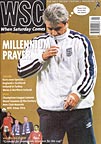 Having got used to relegation from the top flight, Huw Richards writes on how Rayo Vallecano are having an unexpected prolonged stay at the top
Having got used to relegation from the top flight, Huw Richards writes on how Rayo Vallecano are having an unexpected prolonged stay at the top
El Rayo Vallecano está de moda (Rayo Vallecano are in fashion). One can think of more unlikely headlines – “Manchester United back profit-sharing” or “Swansea sign midfield playmaker” come to mind. But few others.
The idea of Madrid’s third team being fashionable is a contradiction in terms. A few years back a Spanish sitcom’s entire premise was that its characters were members of a Rayo supporters club, whose behaviour was deemed to be inherently comic. Still more surprising is that a couple of months after the sports daily Marca came out with that improbable pronouncement, Rayo still led the Primera Liga.
The shock extends beyond the sizeable proportion of the Spanish media who regard it as an offence against nature when anyone other than Real or Barcelona heads the table. Rayo’s eight previous seasons in the Primera have been spread across four spells, with a best position of tenth. Last season they were fifth in the second division, entitled to a play-off shot only because Atlético Madrid reserves, inThere is a glorious quirkiness about Rayo. Their postal address translates as “Fofo the Clown Street”, the club shop compensates for lack of shelf space by displaying items underfoot and for years the idol of the fans was Onesimo, a winger so true to his position’s trad- ition of barminess that I once saw him kick hell out of the wall behind the goal after feckless strikers had wasted another perfect cross.
Four seasons ago they beat Zaragoza 4-3 in a vital relegation match (shorthand for most Rayo Primera matches played after Christmas) that included four sendings-off and four penalties. Their support is extraordinarily localised in the district of Vallecas. Travel south by metro from the city centre until you emerge from Portazgo station, so close to the stadium that the trip from Arsenal station to Highbury looks like a major hike. The Estadio Teresa Rivero is reassuringly familiar to anyone who follows rugby league – so hemmed in by blocks of flats at one end that there is a wall and a narrow walkway rather than terracing behind the goal.
The eponymous Teresa Rivero is the club president, appointed in 1994 in succession to her husband Jose Maria Ruiz-Mateos, Rayo’s majority shareholder. At the time she was pictured with a Rayo scarf across her shoulders, looking about as comfortable as the Queen wearing one of Jorge Campos’s jerseys. The combination of owners who did well under Franco and the left-leaning traditions of the Vallecas area is another Rayo quirk, but Señora Rivero now looks much happier in the role.
Her relationship with the fans is built on shared paranoia – at least the equal of Celtic’s – about referees. She professed herself unsurprised by Rayo’s spectacular start, although coach Juande Ramos refused to get excited, explaining he was far more concerned with survival than Europe.
The formula is a familiar one for smaller clubs punching above their weight – good organisation, particularly in defence, and a capacity for counter-attacking that has brought them several away wins. While British attention has naturally focused on former Leicester keeper Kasey Keller, the great hero for Rayo fans is full-back and captain Jesus Cota, whose defensive skills and willingness to get to know seven or eight new team-mates a year have made him a totem of stability across a dozen seasons and 350 games. For Rayo fans he has the symbolic importance of the Tower ravens.
Relegated three times in five Primera seasons (and a play-off survivor in a fourth), he will be as surprised as anyone if Rayo’s challenge is sustained into the new year. But as any fan of Swansea, Millwall, Watford or any club that has enjoyed a run at the top, however brief, will tell you, the sheer unexpectedness of it all is perhaps the greatest joy.eligible for promotion, came above them.
From WSC 155 January 2000. What was happening this month